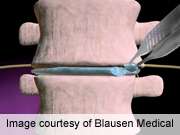(HealthDay)—For patients undergoing posterolateral fusion (PLF) of the lumbar spine, smoking is associated with increased rate of pseudarthrosis among those undergoing two-level, but not single-level, PLF, according to research published in the Oct. 1 issue of Spine.
Mohamad Bydon, M.D., from the Johns Hopkins University School of Medicine in Baltimore, and colleagues conducted a retrospective medical record review involving all adult patients who underwent single- and two-level instrumented PLF without interbody devices for degenerative spine disease. Two hundred eighty-one patients were included from a single institution during a 21-year period. Of the patients, 82.21 percent were nonsmokers and 17.9 percent were smokers. Patients were followed for an average of 53.5 months.
The researchers observed no significant difference in the complication rates for nonsmokers versus smokers (3.57 versus 7.69 percent; P = 0.353) among those undergoing single-level fusion. Pseudarthrosis occurred in 9.82 percent of nonsmokers and 7.69 percent of smokers (P = 0.738). Complication rates were not significantly different for nonsmokers and smokers undergoing two-level PLF (6.72 versus 4.17 percent; P = 0.638), but the smokers group had significantly higher pseudarthrosis rates (29.17 versus 10.92; P = 0.019).
"The findings in this study suggest that smoking has a significant impact on pseudarthrosis rates after two-level PLF of the lumbar spine, but not necessarily on single-level PLF," the authors write.
Relevant financial activities outside the submitted work were disclosed: consultancy, grants, stocks, travel expenses.
More information: Full Text (subscription or payment may be required)
Journal information: Spine
Copyright © 2014 HealthDay. All rights reserved.
























